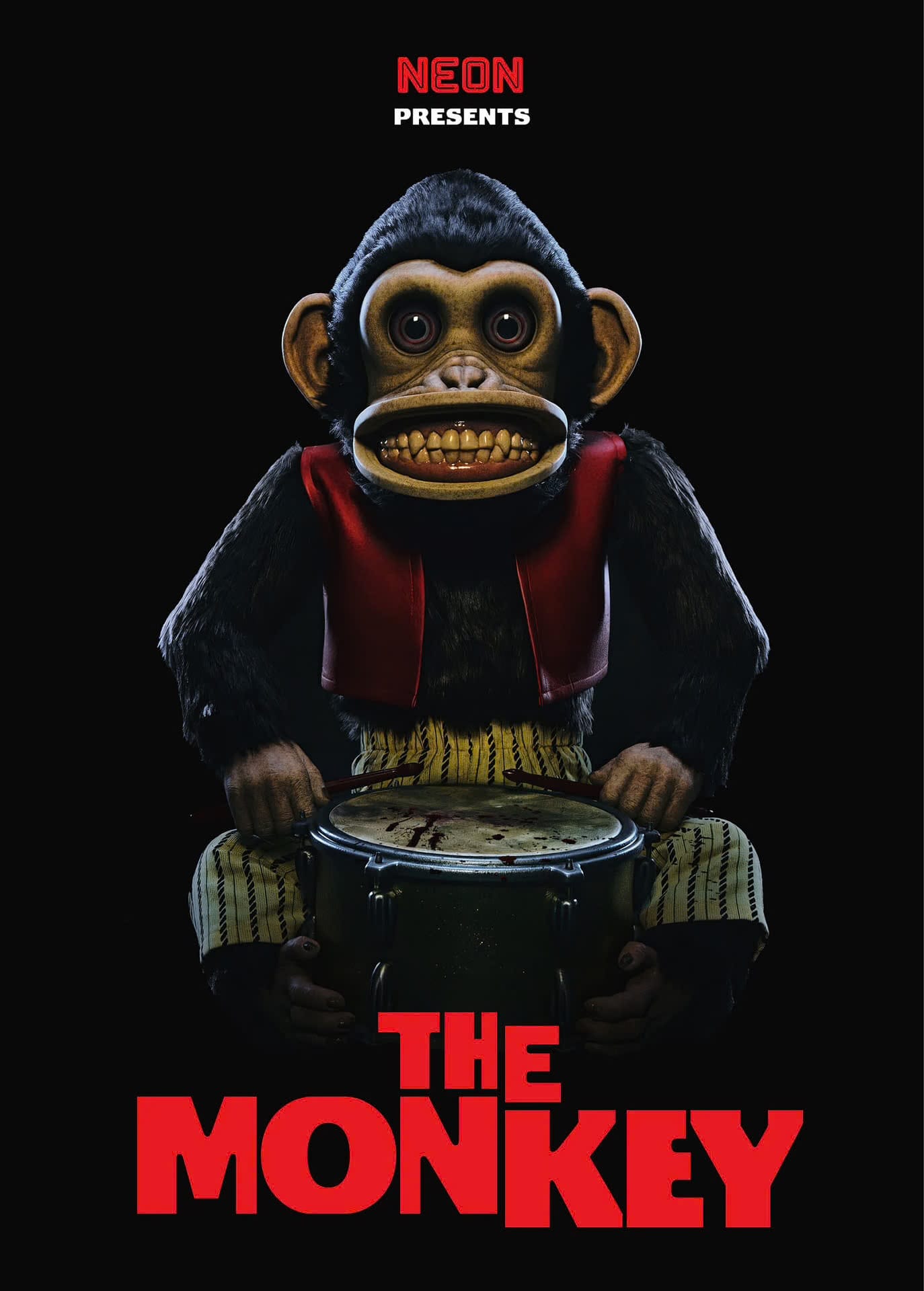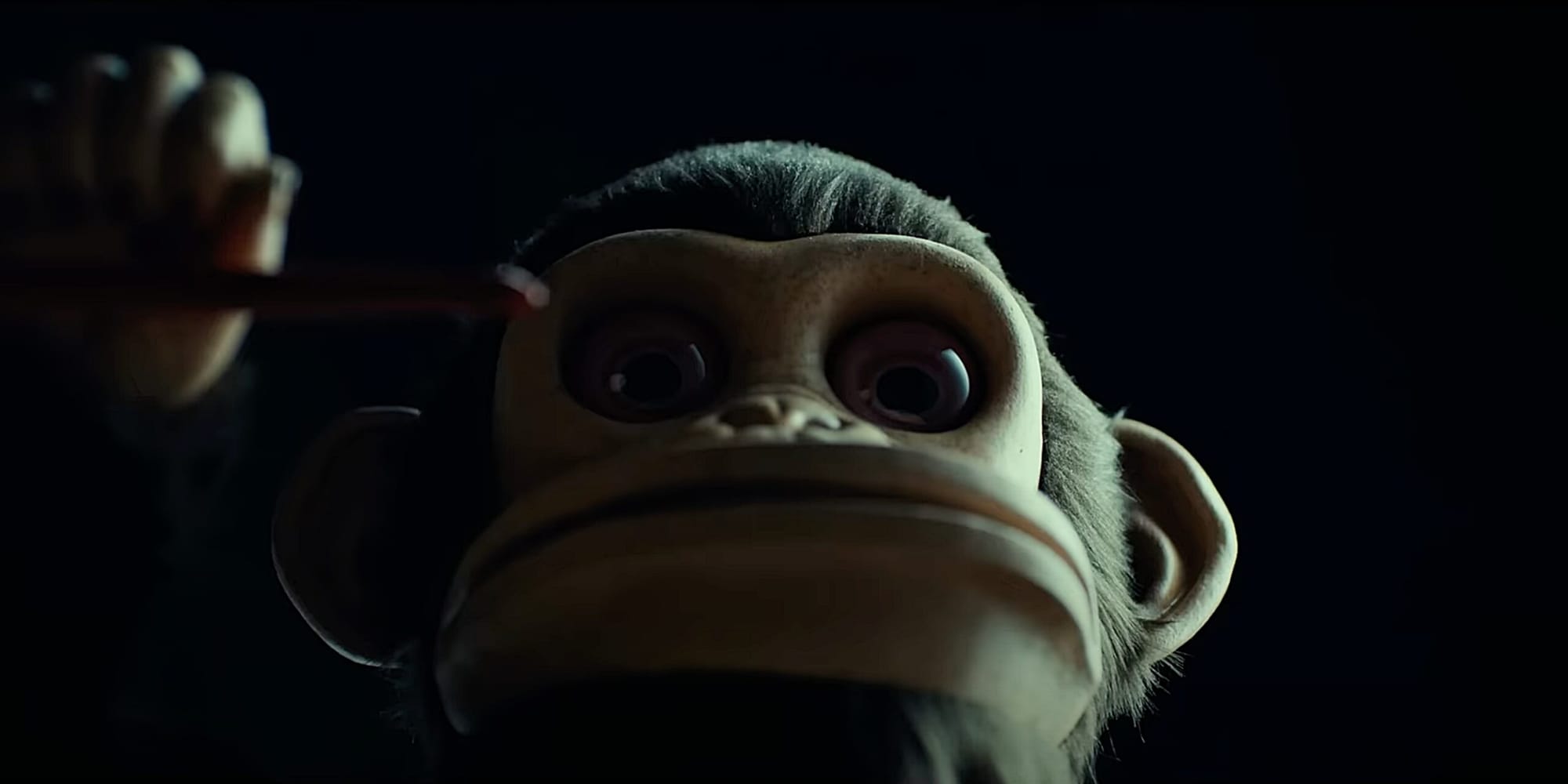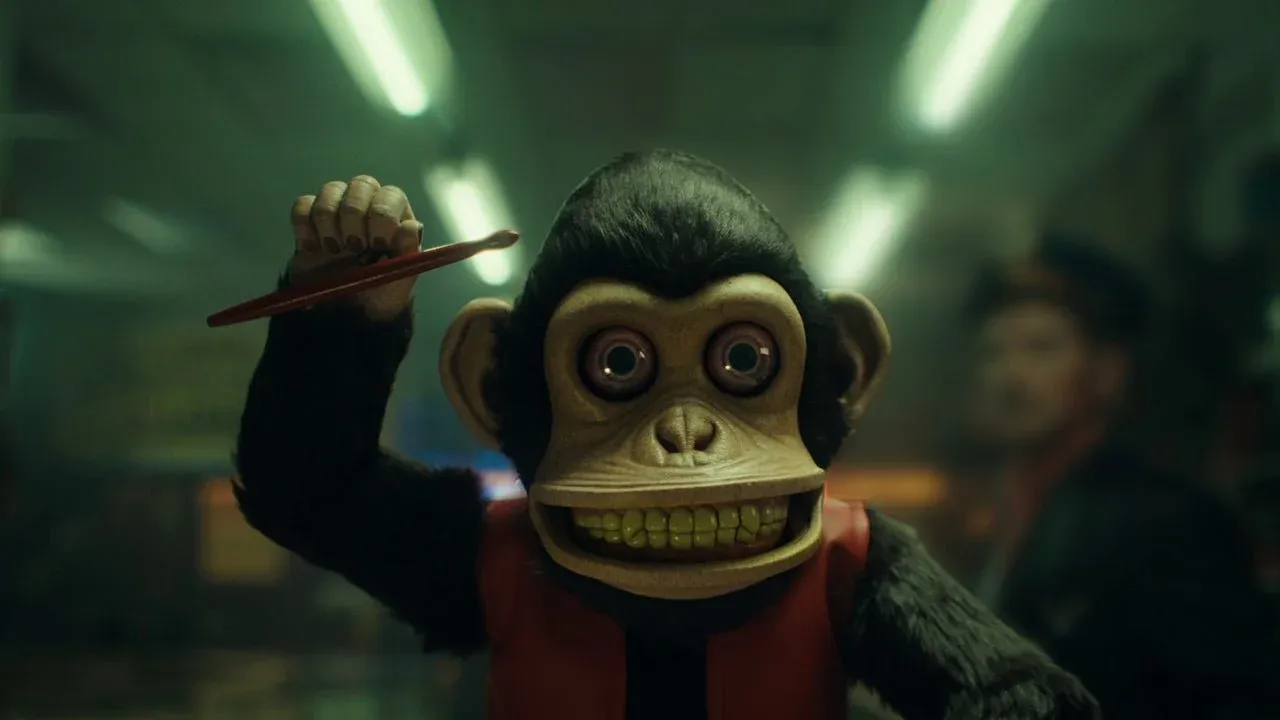The Monkey
“I don’t know if every father passes some secret horror onto his kids… but mine sure did.”

When twin brothers find a mysterious wind-up monkey amongst their father’s old things in the back of a closet, a series of outrageous deaths tears their family apart. Twenty-five years later, the monkey returns and begins a new killing spree, forcing the estranged siblings to confront the cursed toy once and for all.
Based off a Stephen King short story from the early 80s featuring a cursed cymbal-banging monkey toy, this adaptation was written and directed by Osgood Perkins. Perkins has a fantastic style, and made a big splash last year with their previous film, the creepy, good looking, but ultimately unsatisfying Longlegs.
But now, for me at least, after having seen their sophomore effort, The Monkey, I'm starting to see a pattern, and I'm beginning to suspect that they might actually be a lot of sound and fury, but in the end, signifying nothing, as the saying goes.

So…
In 1999, a man named Petey Shelburn attempts to return a wind-up drum-playing toy monkey to a thrift store/pawn shop. Before he can do so, the monkey begins to play its drums, and a chain reaction begins that then ends with a harpoon gun in the shop disemboweling the shop owner. After melting the toy monkey down with a handy flame thrower found on the shop’s shelf, Petey disappears, leaving his wife Lois alone to raise their twin sons Hal and Bill. Or as their mother says, drunk and despondent, he went out for a pack of cigarettes and never came back.
As for the twins, Hal is the nerd who is constantly picked on by his slightly older brother Bill, who is a douchebag. Bill sometimes also ropes in a weird gang of girls to pick on Hal. These girls all have side ponies, fanny packs, and leg warmers, like they’re refugees from a Different Strokes episode where the Gooch’s sister picks on Arnold, and Arnold is forced to learn the value of misogyny or something esle that is casually 1980s awful.
Anyway, desperate for any hint of who their father was and why he left, the boys find the monkey among their father's belongings in the back of an closet, and wind its key. That evening, even though it doesn't seem to be anyone's birthday, while at Benihana with their babysitter Annie, the monkey‘s curse causes an accident that ends with Annie being decapitated, and her head frying on the hot table top.
Putting two and two together, Hal becomes obsessed with the monkey, and when Bill's bullying goes too far, he winds the monkey's key, demanding that the monkey kill his brother. Instead, their mom suffers an explosive aneurysm and dies in front of Bill. Forced to move to Maine with their aunt Ida and uncle Chip, they wind the key again, this time causing uncle Chip to die in a camping trip, after he's trampled into paste in his sleeping bag by a freak wild horse stampede. Looking to break the curse, the twins throw the monkey down a well.
25 years later in 2016, the year of the monkey, it returns.
At this point in their lives, the boys are estranged, and Hal lives an isolated life, paranoid and traumatized by his past. He is also estranged from his ex-wife, her new husband, and his son Petey. His ex-wife plans to have her new husband adopt Petey, and cut Hal from the boy’s life. Bill is spending one last weekend with Petey when Bill calls him and tells him that Aunt Ida is dead in a freak accident. They both know this means that the monkey is back. Bill demands that Hal go to Aunt Ida’s house and recover the monkey, so that they can destroy it for good this time.
After this, the film is a series of increasingly involved and improbable death scenes, a veritable cornucopia of sanguinary extravaganzas, as the monkey wrecks havoc on the twins’ lives, as well as the world around them. And in the end, this is all an effort on the boys' part to avoid their fates as caretakers of the drum monkey, or as the film puts so much effort into making you understand, real world pale riders upon a pale horse, ruthless and random arbiters of death.

First of all, how amazing is Tatiana Maslany, right? Absolutely amazing is the answer. She-hulk? Orphan Black? C’mon. Love her. Like Sunita Mani, I’ll always turn out for a movie with her in it.
As for the rest of the film... the Monkey is disappointing and dull.
Osgood Perkins clearly remembers a world where everyone was wearing moonboots and riding around in their parents avacado and fake wood-paneled station wagons, and I love that. I love that whole look. The late 70s, early 80s shag carpeting and heavy wood furniture world, a time where custard yellow phones with long twisted cords were tacked to the walls in kitchens that were brown and orange and seemed to have fall harvest motifs, is such a beautifully ugly and yet also homey-feeling time. It's also a creepy time, as everything feels like faded old polaroids destined for the trash, and the banality of this world, with it's clearly average and mediocre JC Penny stylings, only highlights how horrifying the events that happen there are. I love that. It gives his worlds a very palatable flavor. It's all a very effective choice for a horror director.
But also, having now seen two of his movies, I'm starting to wonder if that's all he has. Will everything they do be filtered through this same lens? Is that their whole gimmick? Is everything from them going to be mullets, members only jackets, big TVs, clunky necklaces, and rickety swingsets, all set in the perpetually muddy time of year in the more suburban/small town areas of the Northern U.S. when fall has not quite become winter? Is it too soon to call Osgood Perkins a one-trick pony? Maybe. But at this point, I'm now watching to see if that's the case. And either way, it's clear to me at this point that his priority is clearly the aesthetic, not the story.
So, because of this, in the end, The Monkey is nothing but a lesser Final Destination. That means that the whole point of this film is that its a series of situations where a character dies in some crazy way, so the tension is derived from telegraphing the multitude of crazy ways that a character is possibly going to die in that scene, so that audience is then waiting with bated breath with the question of when and how is the death going to happen. Wash, rinse, repeat. The problem with this is two-fold. One, it's a gimick that quickly wears out it's welcome after a couple of spins, and two, the answer to "how is the death going to happen" in this movie is rarely very shocking and definitely never scary, or even all that inventive, and is mostly just a sudden blast of splatter. Which is fine, I guess. Your mileage may vary, but for me at least, splatter alone doesn’t do much for me.
On top of that, the film is set in a world where everyone seems depressed, uncomfortable, and/or awkward, and everything they say has this disconnected, unhinged, weirdly overly-honest, very stylized quality to it. It feels too deliberate, like it’s intended to be a kind of rougher horror movie version of Wes Anderson’s style, but it teeters way too far into try-hard. It feels smug, like it’s always winking at the audience because it believes it’s too smart for the subject, because it believes that it‘s so shocking, because it believes it’s so wild, so above it all. It feels broad and snickering, like it’s mugging for the camera, just so self-amused. I’d say that it reminds me of Jimmy Fallon in every SNL skit, but that feels too mean. But also, it’s kind of accurate. And again, your mileage may vary when it comes to your own personal tolerance of this, but for me, the thing that the overly flippant feel to the dialogue really does, is undermine the already shaky reality of the film’s world.
Perhaps this film was meant as a metaphorical glimpse into the private world of children, with all its strange and sudden dangers, which is why it looks like it was set in an 80s-ish era, a time when children were still allowed to go off on their own and create their own private worlds. Maybe it was an attempt to say something about the cycle of abuse, or maybe the trauma of broken families, or maybe it was something about inevitability and randomness of death, I'm not really sure. The monkey might have been meant to represent suppressed childhood trauma, or maybe a person's repressed destructive impulses? The abundant gore might have be an intent to highlight the absurdity and pointlessness of death. I can't really say for certain. Because The Monkey lacks any kind of subtlety at all, it’s just too hard to say what the film‘s thematic intent really was.
All I know for certain is, having now seen two of their films, I am not impressed by Osgood Perkins’ storytelling ability.
In a nutshell, I liked Longlegs, but I didn’t love Longlegs, and the reason I didn’t love Longlegs is because it just didn’t work in the end. The Monkey is basically all of the problems that Longlegs had, with less of the stuff that made it good, most of which seemed to have been replaced with this smug assurance that the whole thing was so edgy and awesome, and that's summed up for me by the film's unsatisfying and meaningless conclusion… This Napoleon Dynamite meets Rushmore splatter-fest is a film that is more concerned with the idea of being shocking, then with actually being shocking.
Hard pass on this one.
